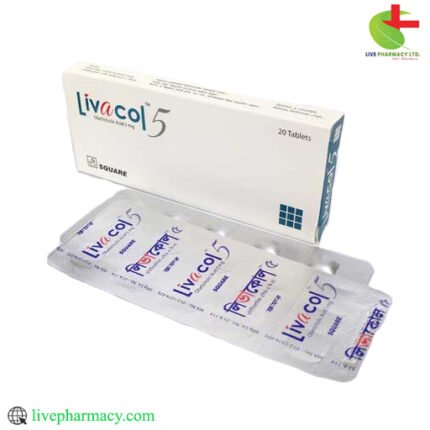Livacol 10
550.00৳ Strip
- Introducing Choliva: A cutting-edge treatment for primary biliary cholangitis (PBC) in adults.
- Powered by obeticholic acid, Choliva targets the Farnesoid X Receptor (FXR), modulating bile acid pathways.
- Offers options: Can be used alone or alongside ursodeoxycholic acid (UDCA) for patients unresponsive to traditional therapies.
- Careful monitoring and dosage adjustments ensure tailored treatment and improved patient outcomes.
 Brand
Brand
|
Square Pharmaceuticals PLC |
|---|---|
 Generics
Generics
|
Obeticholic Acid |
Indications
Choliva is prescribed for treating adult patients diagnosed with primary biliary cholangitis (PBC) who do not have cirrhosis or have compensated cirrhosis without signs of portal hypertension. It can be used either alongside ursodeoxycholic acid (UDCA) if there’s an inadequate response to UDCA, or as a standalone treatment for patients unable to tolerate UDCA.
Pharmacology
Mechanism of Action: Obeticholic acid acts as an agonist for the Farnesoid X Receptor (FXR), a nuclear receptor present in the liver and intestines. FXR plays a crucial role in regulating bile acid, inflammatory, fibrotic, and metabolic pathways. Activation of FXR reduces hepatocyte concentrations of bile acids by inhibiting their synthesis from cholesterol and increasing their transport out of the hepatocytes. This mechanism helps in regulating the circulating bile acid pool and promoting choleresis, thereby reducing hepatic exposure to bile acids.
Pharmacodynamics: In clinical trials, administration of Obeticholic acid at 10 mg once daily led to a 173% increase in FGF-19 concentrations, an FXR-inducible enterokine involved in bile acid homeostasis, from baseline to Month 12. Concentrations of cholic acid and chenodeoxycholic acid decreased by 2.7 micromolar and 1.4 micromolar, respectively, from baseline to Month 12. The clinical significance of these findings is not fully understood.
Cardiac Electrophysiology: Obeticholic acid, even at a dose 10 times the maximum recommended dose, does not significantly prolong the QT interval.
Dosage & Administration
Important Dosage and Administration Instructions: Before initiating Obeticholic acid treatment, healthcare providers must assess whether the patient has decompensated cirrhosis (e.g., Child-Pugh Class B or C), a history of decompensation events, or compensated cirrhosis with signs of portal hypertension (e.g., ascites, gastroesophageal varices, persistent thrombocytopenia) as Obeticholic acid is contraindicated in these cases.
Recommended Dosage Regimen: For PBC patients without cirrhosis or with compensated cirrhosis without evidence of portal hypertension who have not responded adequately to UDCA or cannot tolerate it:
- Start with 5 mg once daily for the first 3 months.
- After 3 months, for patients not achieving an adequate reduction in ALP and/or total bilirubin and tolerating Obeticholic acid, increase the dosage to a maximum of 10 mg once daily.
Monitoring: Patients should be routinely monitored during Obeticholic acid treatment for biochemical response, tolerability, and progression of PBC. Close monitoring is essential for patients with compensated cirrhosis, concomitant hepatic diseases, or severe intercurrent illness.
Management of Patients with Intolerable Pruritus: For patients experiencing intolerable pruritus on Obeticholic acid, management strategies may include adding antihistamines or bile acid-binding resins, reducing the dosage of Obeticholic acid, or temporarily interrupting its dosing.
Interaction
Bile Acid Binding Resins: Bile acid binding resins, such as cholestyramine, colestipol, or colesevelam, may reduce the absorption and efficacy of Livacol. If taking a bile acid binding resin, Livacol should be taken at least 4 hours before or after the resin.
Warfarin: Co-administration of warfarin and Livacol may affect the International Normalized Ratio (INR). Monitoring of INR and warfarin dosage adjustment may be necessary.
CYP1A2 Substrates with Narrow Therapeutic Index: Livacol may increase the exposure to concomitant drugs that are CYP1A2 substrates. Therapeutic monitoring of such drugs is recommended when co-administered with Livacol.
Contraindications
Obeticholic acid is contraindicated in patients with decompensated cirrhosis, compensated cirrhosis with evidence of portal hypertension, or complete biliary obstruction.
Side Effects
Common side effects of Livacol include pruritus, fatigue, and stomach pain. Other common side effects may include rash, joint pain, oropharyngeal pain, dizziness, constipation, abnormal thyroid function, and eczema.
Pregnancy & Lactation
The safety of Obeticholic acid during pregnancy and lactation has not been established. The potential benefits should be weighed against the risks before using Obeticholic acid during pregnancy or lactation.
Precautions & Warnings
Special precautions are required for patients with hepatic decompensation, severe pruritus, or reductions in HDL-C levels during treatment with Livacol.
Use in Special Populations
The safety and effectiveness of Livacol in pediatric patients and geriatric populations have not been established. Patients with hepatic impairment should not use Livacol.
Overdose Effects
In cases of overdose, patients may experience hepatic adverse reactions. Supportive care should be administered as appropriate.
Therapeutic Class
Livacol belongs to the class of Farnesoid X Receptor Agonists.
Storage Conditions
Livacol should be stored below 30°C in a dry place, protected from light, and kept out of children’s reach.













Reviews
There are no reviews yet.